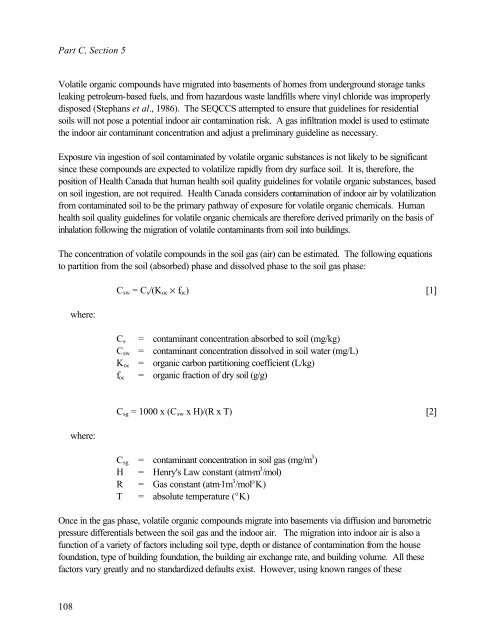Protocol for the Derivation of Environmental and Human ... - CCME
Protocol for the Derivation of Environmental and Human ... - CCME
Protocol for the Derivation of Environmental and Human ... - CCME
Create successful ePaper yourself
Turn your PDF publications into a flip-book with our unique Google optimized e-Paper software.
Part C, Section 5<br />
Volatile organic compounds have migrated into basements <strong>of</strong> homes from underground storage tanks<br />
leaking petroleum-based fuels, <strong>and</strong> from hazardous waste l<strong>and</strong>fills where vinyl chloride was improperly<br />
disposed (Stephans et al., 1986). The SEQCCS attempted to ensure that guidelines <strong>for</strong> residential<br />
soils will not pose a potential indoor air contamination risk. A gas infiltration model is used to estimate<br />
<strong>the</strong> indoor air contaminant concentration <strong>and</strong> adjust a preliminary guideline as necessary.<br />
Exposure via ingestion <strong>of</strong> soil contaminated by volatile organic substances is not likely to be significant<br />
since <strong>the</strong>se compounds are expected to volatilize rapidly from dry surface soil. It is, <strong>the</strong>re<strong>for</strong>e, <strong>the</strong><br />
position <strong>of</strong> Health Canada that human health soil quality guidelines <strong>for</strong> volatile organic substances, based<br />
on soil ingestion, are not required. Health Canada considers contamination <strong>of</strong> indoor air by volatilization<br />
from contaminated soil to be <strong>the</strong> primary pathway <strong>of</strong> exposure <strong>for</strong> volatile organic chemicals. <strong>Human</strong><br />
health soil quality guidelines <strong>for</strong> volatile organic chemicals are <strong>the</strong>re<strong>for</strong>e derived primarily on <strong>the</strong> basis <strong>of</strong><br />
inhalation following <strong>the</strong> migration <strong>of</strong> volatile contaminants from soil into buildings.<br />
The concentration <strong>of</strong> volatile compounds in <strong>the</strong> soil gas (air) can be estimated. The following equations<br />
to partition from <strong>the</strong> soil (absorbed) phase <strong>and</strong> dissolved phase to <strong>the</strong> soil gas phase:<br />
where:<br />
C sw = C s /(K oc × f oc ) [1]<br />
C s = contaminant concentration absorbed to soil (mg/kg)<br />
C sw = contaminant concentration dissolved in soil water (mg/L)<br />
K oc = organic carbon partitioning coefficient (L/kg)<br />
f oc = organic fraction <strong>of</strong> dry soil (g/g)<br />
where:<br />
C sg = 1000 x (C sw x H)/(R x T) [2]<br />
C sg = contaminant concentration in soil gas (mg/m 3 )<br />
H = Henry's Law constant (atm⋅m 3 /mol)<br />
R = Gas constant (atm⋅1m 3 /mol°K)<br />
T = absolute temperature (°K)<br />
Once in <strong>the</strong> gas phase, volatile organic compounds migrate into basements via diffusion <strong>and</strong> barometric<br />
pressure differentials between <strong>the</strong> soil gas <strong>and</strong> <strong>the</strong> indoor air. The migration into indoor air is also a<br />
function <strong>of</strong> a variety <strong>of</strong> factors including soil type, depth or distance <strong>of</strong> contamination from <strong>the</strong> house<br />
foundation, type <strong>of</strong> building foundation, <strong>the</strong> building air exchange rate, <strong>and</strong> building volume. All <strong>the</strong>se<br />
factors vary greatly <strong>and</strong> no st<strong>and</strong>ardized defaults exist. However, using known ranges <strong>of</strong> <strong>the</strong>se<br />
108
















